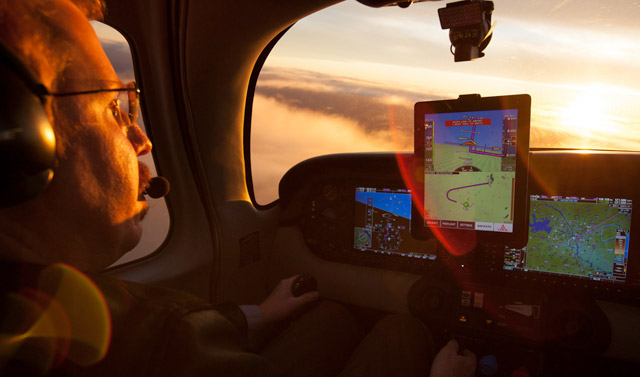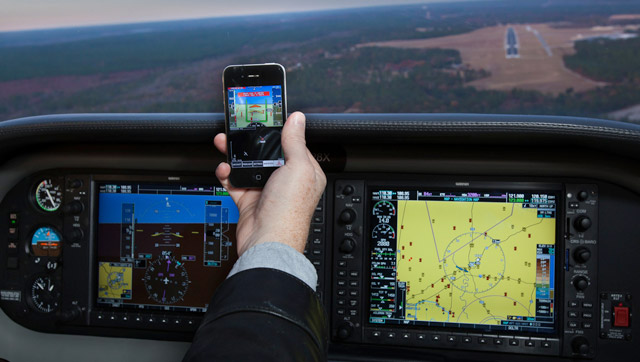 Austin Meyer at the controls with the Xavion app he created. Photo courtesy X-Avionics/Austin Meyer.
Austin Meyer at the controls with the Xavion app he created. Photo courtesy X-Avionics/Austin Meyer.
South Carolina pilot Austin Meyer is an angry man these days. Furious, in fact. But it will be a while before he can tell you exactly why, if you’re asking for the record: Locked in a federal court battle over electronic rights, Meyer, author of the X-Plane flight simulator and a new application called Xavion designed to enhance safety in the cockpit, is precluded from speaking as freely as he would like. His lawyers have advised extreme caution while the case is going on, and years will likely pass with millions spent before a jury gets to hear this story in detail.
The case was among many filed in 2012 by a Luxemborg-based company called Uniloc that has apparently amassed a collection of similar patents, including the one being enforced in the U.S. District Court for the Eastern District of Texas. For those with any interest in being able to fly an emergency glide to the nearest airport guided by an Android tablet or phone—or, potentially, interest in any other aviation application for Google’s popular platform—it is one to watch.
Meyer said in a telephone interview with AOPA that he expects to spend seven figures defending a “frivolous” claim that he violated what Uniloc claims in court to be a patent on electronic copy protection that prevents unauthorized duplication or use. In Meyer’s particular case, ownership of software code protecting X-Plane for Android from unauthorized use is at the heart of the dispute, though Uniloc has targeted a variety of software makers and programs.
‘The path of least resistance’
Meyer said the code in question is used by virtually all Android developers; Google did not immediately respond to a request for comment. Federal court records list 394 patent cases involving Google as a named party since 1999; more than half of those, 224, were filed in 2010 or later—none of those cases against Google were filed by Uniloc, which has not been shy about targeting other firms.
Uniloc has plenty of company, and the legal claims being made are often murky. The nonprofit Electronic Frontier Foundation (EFF) has frequently weighed in on similar cases, and describes on its website an “explosion” of litigation in recent years amid conflicting interpretations by various courts of what constitutes a patentable idea in the electronic age.
In a brief filed in one of these cases, EFF attorneys noted that more than 4,000 patent enforcement actions were filed in 2011, compared to 3,000 in 2009, and about 1,500 in 1992. (Others have published estimates that are higher still.) The increase is being driven by “non-practicing entities, companies that amass patents with no intent to produce anything.” EFF wrote that cases filed by “‘patent trolls,’ have significantly increased, “accounting for roughly 5 percent of all patent litigation from 2000 to 2002, increasing to 22 percent in 2007, and 40 percent of patent cases filed in 2011.”
Uniloc in 2010 created a subsidiary called BlueCava, which may produce software of its own, based on a reading of the company website. It is unclear of BlueCava offers software in addition to consulting and analytical services. Uniloc itself offers to license technology covered by more than 50 patents: “The cost of licensing is quite modest when compared to other alternatives,” Uniloc’s website states.
Meyer said that based on his own research, a typical patent defense costs at least $1.5 to $2 million in legal fees by the time a jury hears the case, if it ever goes that far—excluding any damages that may be awarded. He said he will spend whatever it takes, rather than settle for a fraction of that cost, “because I believe that I am being sued partially because others have taken the path of least resistance, and settled.”
While Meyer was circumspect, Uniloc officials and attorneys did not respond to a request for comment.
Uniloc has made patent enforcement central to its business: Federal court records list more than 200 cases filed by Uniloc since the company sued Microsoft in 2003 and won a $388 million jury verdict. That case was settled in the midst of appeals in April 2012, with undisclosed terms, and Uniloc promptly filed 174 new cases before the end of the year. Uniloc’s targets to date include household names such as Adobe, Symantec, and McAfee. Electronic Arts, a leading video game producer, and Meyer’s Laminar Research, producer of X-Plane, were among those named in the latest wave. They are among eight defendants whose cases involving Uniloc were consolidated for pretrial purposes on Feb. 1 by U.S. District Court Judge Leonard Davis.
 Austin Meyer's Xavion can use the internal sensors of an iPhone to create backup instruments and calculate an emergency approach. Photo courtesy X-Avionics/Austin Meyer.
Austin Meyer's Xavion can use the internal sensors of an iPhone to create backup instruments and calculate an emergency approach. Photo courtesy X-Avionics/Austin Meyer.
‘A tax on innovation’
Defendants—and observers including the Electronic Frontier Foundation—argue that patents being enforced in this burgeoning branch of legal practice are too vague and too broad to deserve protection. Court rulings have been mixed, leaving lawyers and inventors with no certain guidance about what claims are enforceable and what claims are not, particularly in the digital realm.
The 1996 patent at the center of the Microsoft case (awarded to Uniloc founder Frederic B. Richardson, III, according to the U.S. Patent and Trademark Office database) is similar to the patent central to Uniloc’s case against Meyer, though the patent Meyer and others are accused of violating was awarded in 2005 to another individual with no apparent connection to Uniloc .
Meyer’s legal team contends the idea is older than that, dating to the widespread implementation of “digital rights management” (DRM) in the 1980s. The patent Uniloc accuses Meyer and others of violating includes no computer source code, the basic instructions behind every application, just a general description of methods.
“By the early 2000s, the timeframe from which the Asserted Patent emerged, the DRM space was well developed,” Laminar Research attorneys wrote in court documents filed in October 2012 denying Uniloc’s claims and demanding a jury trial.
“On information and belief, no one associated with Uniloc had any involvement in the development of Creative Software’s commercial system or with the Asserted Patent. Instead, Uniloc, on information and belief, acquired the Asserted Patent in 2012 and promptly thereafter initiated the instant lawsuit.”
Electronic Frontier Foundation attorneys have noted that companies like Apple and Google spend more on patent litigation than research and development, and smaller companies are often driven out of business. “Simply put, the patent system is too often serving as a tax on innovation, when it should be spurring innovation.”
‘Sometimes, you have to put your foot down’
Xavion will be reviewed in detail in an upcoming issue of AOPA Pilot. It is available only for Apple devices—iPhone and iPad—though it would not be a technical challenge to adapt it for Android. The legal challenge is another matter. Meyer has no plans to release an Android version with the Uniloc case pending.
The app uses GPS technology and iPad’s internal sensors (accelerometers) to create an “approximate” backup of the six-pack instruments. Pull the power in flight, and Xavion has already calculated glide ratio, and instantly creates a moving map display showing the maximum glide distance available. Pilots can see at a glance what airports are in range.
The program runs those calculations in real time, incorporating factors such as aircraft performance and runway requirements. In an instant, it can create a guided power-off approach, a synthetic “highway in the sky” calculated to be most likely to succeed, with built-in safety margins including a slightly steeper descent to allow for unfavorable winds. It accepts input from a variety of GPS and electronic gyroscope sources, if available, but will also function with the device alone—an electronic copilot that can fit in the palm of your hand.
It retails for $99.99, and Meyer has just brought it to market. An Android release hinges now on a successful approach to litigation freedom, a process likely to require years.
“I got my degree in aerospace engineering and I don’t want to spend the rest of my life in court,” Meyer said. “Sometimes, you have to put your foot down, you just have work.”



